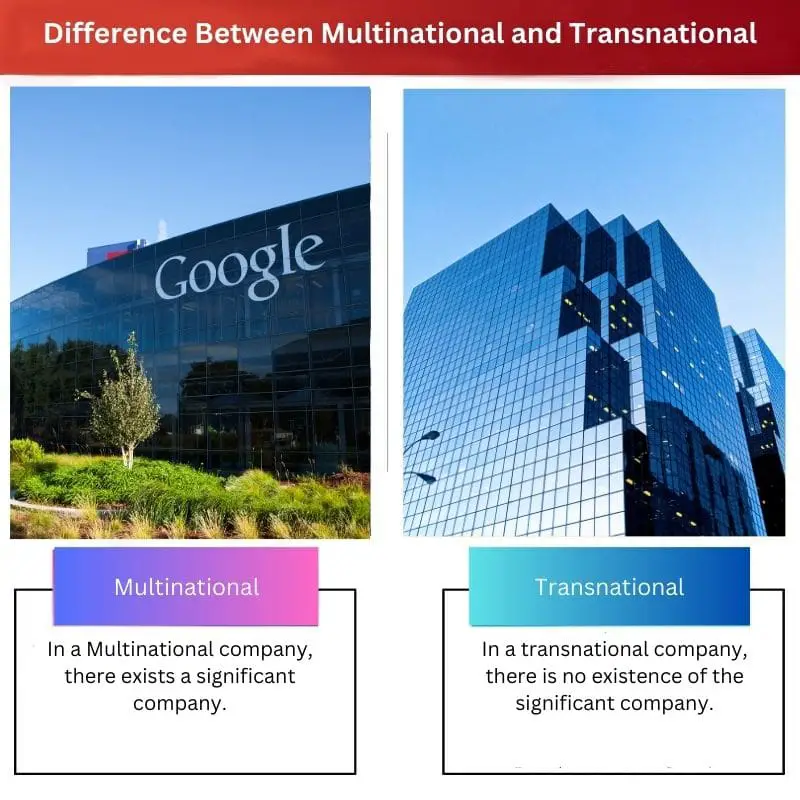There are a few types of companies when a person wishes to incorporate one. Two such companies are multinational and transnational. Both these companies are operated worldwide.
Some scholars say that multinational and transnational companies are very similar and can be used in place of each other. But this is not entirely true since they have some differences.
Key Takeaways
- Multinational companies have a presence in multiple countries but maintain a centralized management structure, while transnational companies have a decentralized management structure with operations in numerous countries.
- Multinational companies may adapt their products and services to local markets, while transnational companies may develop new products and services for different markets.
- Multinational companies may prioritize profit over social responsibility, while transnational companies may focus more on corporate social responsibility.
Multinational vs Transnational
Multinational corporations have operations in multiple countries and a centralized management structure where decisions about strategy, finance, and operations are made at the headquarters. A transnational corporation is a company that operates in multiple countries and has a decentralized management structure. This means that decision-making is shared among the company’s different subsidiaries.

In the word multinational, multi means many, and national means state. So initially, it means many states. This defines that companies that simultaneously handle their business in more than one country are known as multinational companies.
In a transnational company, one business starts with one name and then expands into other countries. Still, they do not have any significant company which would keep track and hold of it.
Comparison Table
| Parameters of Comparison | Multinational | Transnational |
|---|---|---|
| Home Company | In a Multinational company, there exists a significant company. | In a transnational company, there is no existence of the significant company. |
| Management | There is a centralized system of management that is followed in a multinational company. | There is no centralized system of management that is followed in a transnational company. |
| Barriers | Multinational companies may undergo some barriers regarding decisions to be made for their company. | Transnational companies are free to make decisions as per their operating company needs. |
| Subsidiary companies | A multinational company has many subsidiary companies under it. | A transnational company does not have any subsidiary company under it. |
| Working | In a multinational company, the work is carried out for all the companies. | In a transnational company, working is only for that specific operating country. |
What is Multinational?
In the word multinational, multi means many, and national means state. Companies that simultaneously handle their business in multiple countries are known as international companies.
A company becomes a multinational company when it Operates in any country and later expands the company to many other countries.
A centralized management system means that the leading company makes all the critical decisions regarding the functioning of all the companies under that name.

What is Transnational?
In a transportation company, one company starts its business with one name, and then this company would also get expanded in other countries. Still, they do not have any significant company which would keep track and hold of it.
Therefore they act as all different companies, and the decisions taken regarding the functioning of every transnational company are taken according to the objective of that specific company and not all the companies as a whole.
It is also observed that the company operated under a transnational company isn’t loyal when it comes to maintaining and carrying the same type and amount of budget as the leading company.

Main Differences Between Multinational and Transnational
- A multinational company has many subsidiary companies; conversely, a transnational company has no subsidiary companies.
- In a multinational company, the work is carried out for all the companies. On the other hand, in a transnational company, the work is carried out for that specific operating country only.


The article effectively highlights the key differences in management and structure between these two types of companies.
Absolutely. The breakdown of management and barriers to decision-making is especially enlightening.
This article provides a clear and concise explanation of multinational and transnational enterprises. I think it’s a great resource for anyone seeking to understand these concepts.
I completely agree. The in-depth analysis is very helpful.
This serves as an effective primer for understanding the subtleties between multinational and transnational corporations.
The breakdown of differences is very well articulated. I think the article effectively communicates complex ideas in a reader-friendly manner.
Agreed. The comparison makes it easy to grasp these concepts.
While the comparison is helpful, I think there could be more exploration of the potential challenges and implications of each type of company.
Absolutely. A more critical examination of these structures would add depth to the analysis.
The informative tone of the article combined with the comprehensive coverage makes it a valuable read for anyone interested in business and corporate structures.
I couldn’t have said it better myself. It’s a well-structured piece.
The comparison table makes it very easy to understand the distinctions between multinational and transnational corporations.
Yes, I found it very informative too.
This is a great overview of the differences between multinational and transnational companies. I appreciate the detail.
I agree. It’s important to understand the nuances of these corporate structures.
While informative, the article could perhaps delve into the potential implications of these different corporate structures in more detail.
I see what you’re getting at. It’s a fair point to consider the wider impact.
The article serves as an insightful exploration of multinational and transnational companies, providing a well-rounded understanding that’s both comprehensive and accessible.
I couldn’t agree more. It’s a valuable resource for business studies.